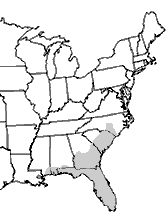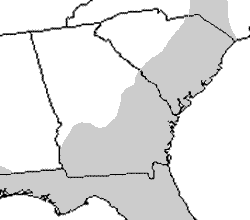River Frog (Rana [Lithobates] hecksheri)
River Frog (Lithobates hecksheri)
![ranhec210 River Frog (Rana [Lithobates] hecksheri)](https://srelherp.uga.edu/wp-content/uploads/sites/70/2024/01/ranhec210.jpg)


Description: A large frog (7–13 cm; 3–5 in), with record lengths exceeding 15.5 cm (6 in). Dorsal coloration varies from green to dark green or greenish-black. The venter is typically medium to dark gray, sometimes nearly black, and often patterned with light spots or short wavy lines. Light spots are usually present on the lips, particularly the lower jaw, which is a key feature distinguishing it from American bullfrogs (L. catesbeianus) and Pig Frogs (L. grylio). Males have larger tympana than their eyes and yellowish throats, while females’ tympana are the same size or smaller than their eyes. Unlike most frogs in the Ranidae family, the skin is rugose (rough and wrinkled). No dorsolateral ridges are present. A pale outline may be visible at the groin. Juveniles have noticeably red eyes. Tadpoles are exceptionally large (up to 12.7 cm; 5 in), with a distinct black margin along the tail fin.
Range and Habitat: Restricted to the Coastal Plain of the southeastern U.S., from southern North Carolina south to Florida and west to Mississippi. Most common in cypress swamps, blackwater streams, and associated wetlands.
Habits: Nocturnal and often more approachable than other ranids. Instead of fleeing, individuals may play dead (thanatosis) or secrete a strong, unpleasant odor when disturbed. Breeding occurs from April to early August. Tadpoles are unusually large and exhibit schooling behavior, which is uncommon in other large-bodied frog larvae.
Call: A deep, low-pitched, rolling snore.
Conservation Status: Locally common in the southern portions of its range, particularly in Georgia, where habitat persists. Declining in the eastern range and is considered extinct in North Carolina. Habitat loss, especially the degradation of blackwater swamps, is the presumed cause. Listed as Least Concern by the IUCN, but with regional conservation concerns.
